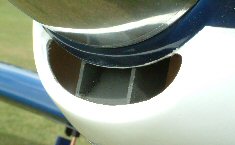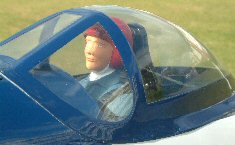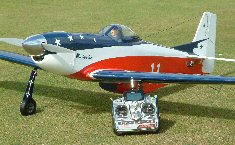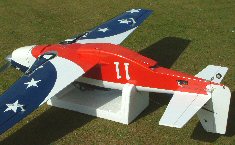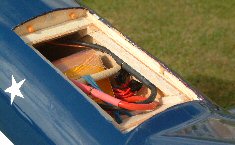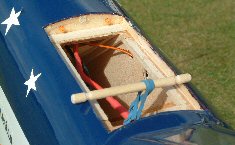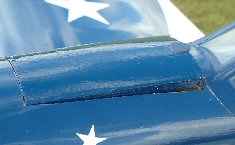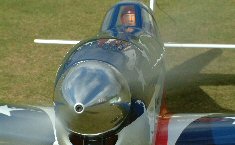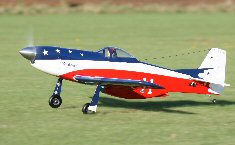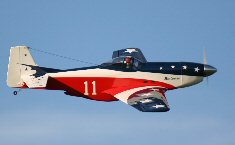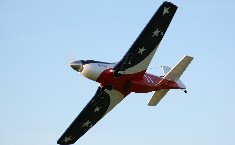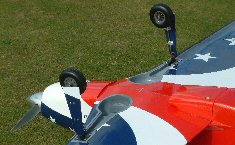|
|||
|
|
|
||
| View Shopping Cart |
| Home |
| Guides Available |
| About the Author |
| FAQs |
| Testimonials |
| Articles |
| Contact Andrew |
| Terms & Conditions |
| Mailing List |
| Links |
 |
 |
More high quality information
absolutely free with every
Gibbs Guides newsletter. Sign
up now!
Hangar 9 P51 D
Electric conversion project
Part 4 - Flight Performance
by Andrew Gibbs

Flight performance – first
flight
Before flying the P51, I carefully checked the whole model
over. Any areas of concern, however small, were rectified
before setting off to the flying field.
At last an opportunity arrived when the combination coincided of suitable weather, a suitable venue and a cameraman (thank you George). The model was then range checked, and the batteries topped up while I 'got my eye in' on a well-known model.
The flying trials were carried out from a grass strip. The grass was not as short as the taxi trials venue, but was probably typical of a good average club field. The first attempt to take off proved that full up elevator on low rates did not provide sufficient elevator authority to prevent a nose-over. No damage was done, so a second attempt was made with more elevator throw. I gradually increased power, and as the model gained speed I progressively relaxed the elevator, allowing the tail to come up.
In spite of having more than 1,000 Watts on tap, the model showed little tendency to yaw during the take off which was a pleasant surprise. To prevent the possibility of a disastrous low-level stall on rotation, I made sure that only a hint of 'up' was present as the model broke ground.
The Mustang rose cleanly into the blue sky, climbing easily even though full throttle still had yet to be reached. The gear was retracted, and the model was found to require only a little trimming; just a few beeps of aileron and it maintained a wings level attitude. In pitch, I found the P51 needed a little down trim to maintain level flight at half throttle, which suggests that my initial assumption about the intended CG reference point was correct.
| The scale chin scoop provides ample air to cool the P51’s power system. As can be seen, the deflector, seen here painted grey, sends around 1/3 of the intake air upwards to the motor. | P51 Mustangs are usually attractive from any angle, and this one’s no exception. |
Half throttle was found to be a comfortable setting for cruising around. Being a reasonably large model, the P51 does not appear to be an exceptionally fast machine, but it was certainly no slouch, as it covered a fair bit of sky quite quickly. It looked very scale-like, which is surely much of the point of a model like this. I was very surprised at how soon I felt comfortable with this enjoyable model. I was quickly happy to make low-level passes and turns (on an otherwise unoccupied flying site) for the benefit of the camera.
After about 6 minutes the undercarriage was lowered, which as expected caused a slight nose-down change in trim. This was easily compensated for by adding some up trim. During the downwind leg, I added a little more up trim and reduced power so that the model was in trim at a lower flight speed, as appropriate for an approach to land.
Landing– first flight
The model was landed gently. As the speed decayed, up
elevator was progresively applied, but this was insufficient
to prevent a nose over.
Power system performance
I’d limited this first flight to 6 ½ minutes,
as I felt this was probably close to the likely safe maximum
duration with a 5,000 mAh pack. I was astounded to find
that only 1,500 mAh was required to replenish the battery.
This represents only 30% of the total battery energy,
and indicates that the model was only consuming an average
of approximately 14 Amps/300 Watts. This is a very surprisingly
modest 34 Watts per pound of model weight, which seems
to indicate that this is a particularly efficient combination
of airframe and power system. Whatever the reason, clearly
considerably longer flights were going to be easily possible.
The battery was slightly warm to the touch after the flight,
indicating that it was adequately (but not excessively)
cooled and that it had plenty of performance in hand.
| The addition of a pilot figure makes is essential to avoid the alarming empty cockpit syndrome, and adds some welcome detail in a prominent part of the aircraft. | The Hangar 9 Mustang builds into a handsome and substantial model. But how will it fly? |
Second flight
During this flight I wanted to further investigate the
model’s behaviour. The model was taken to altitude
and deliberately stalled. I found it had to be slowed
down to a remarkable extent before the stall occurred.
On my example, the stall in a power off condition caused
the left wing to drop. Being a relatively large model,
a significant loss of height occurred after the manoeuvre.
There was no mistaking the high angle of attack necessary
for this model to stall in level flight. I was left feeling
confident that this model would be quite difficult to
stall inadvertently.
Next, a spin was tried; the model was slowed down as for the stall, and just before I judged it was going to stall, full rudder was applied. This caused the model to enter a fairly leisurely spin. Less than one further turn was required for recovery, which was accomplished simply by neutralising the controls.
Aileron control is very smooth and the model showed no sign of adverse yaw. Rolling manoeuvres look beautiful and the model is responsive, but not at all twitchy. There is plenty of power to help the model through large and impressive scale-like loops. Low, fast passes were simple, with the model feeling very stable and controllable.
| I built this simple polystyrene cradle for the fuselage to hold it securely on the workbench. This made the model far easier to work on, and helped to prevent it suffering from dents as I worked on it. | The 5,000mAh LiPo battery is seen here installed and ready for flight. Note how the battery retaining peg prevents the battery from moving in a vertical plane. |
| The grooves in the battery retaining peg align with the holes in the battery tube, while the elastic band keeps the peg lightly tensioned so it cannot become dislodged. | The hatch is retained by a combination of dowels at the front, and a pair of magnets at the rear. The magnets connect with a pair of small wood screws which can be easily adjusted with a screwdriver to position the hatch exactly where required and ensure that the magnets make good contact, ensuring maximum securing force. |
After 11 ½ minutes the model was landed. Again the landing ended in a gentle nose over even though up elevator was progressively fed in as the model slowed. Fortunately no damage resulted. This nosing over tendency was partly due to the length of the grass, but I feel that a contributory factor is the proximity of the wheels to the model’s balance point. Overall though, I was thoroughly impressed with the Mustang’s handling and this factor is really the only thing I can fault about the model’s behaviour.
I was again impressed at how little energy this consumed, with the battery requiring only 2,700 mAh to recharge. This indicates that a 5,000 mAh battery has the potential to fly this model for a maximum of around 20 min. if required, although a shorter flight time would result if full throttle was used a lot.
Third flight
Prior to the third flight, 30 g of lead (about 1 ounce)
was added to the tail of the model to move the CG rearwards
a little. I hoped that this would improve the model's
tendency to nose over on take off and landing. This worked,
and the model was still stable in flight with no bad habits.
| Captain Plastic is captured here checking his instruments while warming up his engine in preparation for his first P51 flight. He probably wouldn't’t have looked so apprehensive if he’d known how well this aircraft was going to fly! | The P51 is seen here in a gentle bounce before breaking ground for the first time. |
Performance Assessment
I would estimate that the performance is similar to a
0.60 i.c. engine on the installed electric power system.
One of the beauties of electric power though is of course
that the performance can be increased, within reason,
simply be changing the prop for one which demands more
current and hence power. I may well try a 16 x 10 and
even a 16 x 12 in the future, although the model already
flies very nicely.
Conclusions
This was a most enjoyable project, even if it did give
me a little brain ache at times! A lot of work went into
the project and it took far longer than I expected. In
fact, the amount of work in planning and carrying out
the conversion greatly exceeded the time required to assemble
the parts of the model which did not need modifying. I
estimate I could have assembled at least five of these
models for i.c. power in the time it took me to build
and convert this one!
However, the result of my efforts was worthwhile; I was rewarded with a beautiful, easy to fly and practical electric warbird (albeit in a civilian colour scheme in this instance) that flies very well.
| The cheerful colour scheme of this P51 variant make for an attractive and unusual warbird model. | The Mustang proved itself to be a stable flier, a characteristic which helps to engender confidence during manoeuvres such as this fast pass. |
| It’s not a huge problem, but the P51s nosing over tendency does need a little attention to sort out. Once this is accomplished, it will be a real thoroughbred of a model. | 38. The retracts worked well once they had benefited from a little fettling. The doors had a slight tendency to move around the leg in flight, but this was easily rectified and did not noticeably affect the flight performance. |
The flight performance and handling of the model is excellent, and I have it on good authority that Hangar 9's other WW2 warbirds handle similarly well. The P51 is not the cheapest model of this size but in view of the quality of the model and its flight performance in particular, I feel its good value for money.
Hangar 9's evergreen Mustang has been around for a while, and I hope it will be around a lot longer so that many more modellers can enjoy its charms.
| Hangar 9 Electric P51 D technical data | ||
| Span | 1,650 mm | 65 inches |
| Length | TBA | TBA |
| Flying weight with battery |
3,998g | 8 lb 13 oz (141 oz) |
| Wing Area | 0.00 sq m | 5.15 sq ft (743 sq in) |
| Wing Loading | 00g/dm | 27.3 oz/sq ft |
| Battery | 1 x 6S 5,000mAh LiPo | |
| Motor | E Flite Power 60 (400 Kv) | |
| Prop | 15 x 8 APC-E, 7,500 rpm | |
| Max Power | 48 A = 1,050W | |
| Power Loading (max power) | 000 W/kg | 120 W/lb |
| Power Loading (average power) | 34 W/lb | |
| Control functions | Ailerons, elevator, rudder, throttle and retracts. | |
Lessons learned
Next time, I'd almost certainly choose 2 x 3S batteries
instead of a single 6S example. This would slightly complicate
charging, but would provide more flexibility in that either
pack could do duty in a model requiring a 3S pack. Also,
if in an accident the 6S pack was to become significantly
damaged it would be of no further use, whereas with a
pair of 3S packs one may survive.
A slightly smaller battery would still be perfectly suitable for this particular model, especially if continuous high speed was not required. This would result in significant cost and weight savings which are always welcome.
For the future
I plan on packing up the rear edge of the retract unit
in order to get the leg to lean further forward when it’s
extended. I may also make some new gear doors which fit
flush with the lower surface of the wing, reducing drag.
Note: All the power system themes touched on here such as power loading, pitch speed and much more are explained clearly in the 3-part series on Electric Power Systems
